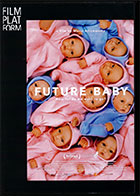
Future Baby 2016
Distributed by Film Platform
Produced by Nikolaus Geyrhalter, Markus Glaser, Michael Kitzberger, Wolfgang Widerhofer
Directed by Maria Arlamovsky
DVD, color, 91 min.
High School - General Adult
Assisted Reproduction, Bioethics, Biology, Business, Occupations, Genetic Disorders, Childbirth, Family Relations, Delivery of Health Care, Health Services, Medicine, Reproductive Rights
Date Entered: 04/06/2018
Reviewed by Joseph Baumstarck, Jr., University of Louisville, Southern Baptist Theological Seminary, Ivy Tech Community CollegeFuture Baby documents a series of clinic visits, laboratory interviews, personal interviews, hospital scenarios, and interviews with reproductive experts in the United States, Mexico, the United Kingdom, and Europe. These interactions, in several different languages, chronicle a wide variety of infertility treatment procedures from several different perspectives. Included are interactions with in vitro fertilization, egg donation, sperm donation, embryo screening, sex selection, other selective processes, storing of reproductive substances and live embryos, surrogacy, and multiple gestations. Most of these areas are covered from several different perspectives with experts in that field often summarizing and commenting on the procedures.
Despite the title, this documentary is not about the future, but about the very real present. All procedures discussed are currently available in at least some country and all are producing living children. Most of the discussions involve introductory level material at a high school level. Even the medical aspects are covered at a similar level with no advanced life science background needed to understand the film. Although the multiple languages are a problem, subtitling helps alleviate much of that difficulty. Unfortunately some of the subtitling lacks contrast with the background color and on some scenes is quite extensive.
Clearly noted in the film is the vast amount of fertility tourism taking place and the legal differences between countries regarding what is considered acceptable infertility treatments. Several of the practitioners point out some of the multitudinous ethical issues and dilemmas posed by many of these processes. Surrogacy along with the storage of reproductive substances and live embryos make up the majority of the ethical discussions in the film. All the practitioners are supportive of the technology they work with, but are not necessarily supportive of all the procedures in the film. The film lacks comprehensive ethical evaluation of infertility associated technologies in general and provides only limited bioethical debate.
Future Baby clearly delineates the extensive economic incentive for practitioners of the various technologies and even notes that some practitioners wear both a medical and a business hat when counselling patients about infertility. Along with the economic issues the film also notes that modern women are not actually counselled aggressively enough about the consequences of delaying pregnancy to beyond thirty-five years of age when infertility becomes more common. Although most women believe forty years of age to be the cut-off for normal fertility several practitioners note that thirty-five is actually the dividing line between normal fertility and rapidly decreasing fertility. The inaccurate assumption of forty as a harbinger of declining fertility based on societal expectations leads many women to delay childbearing until late enough in their lives to require fertility assistance of various types. Several practitioners in the film note that education remains a major part of what they do on a daily basis.
Although the title of the film is Future Baby little of the film addresses the future. Most of the film addresses procedures and discusses situations which are already well established, at least in some areas of the world, and have resulted in the births of millions of normal babies. The aspects of future that are part of this film are mainly bioethical and legal concerns that have not kept pace with the technological capabilities of infertility treatment. In several places legal ramifications, such as ownership of reproductive substances and viable embryos in storage, are mentioned, but invariably are just noted with little detailed exploration. One practitioner notes that this generation of infertility specialists is not reading textbooks on this subject, but is the generation charged with producing them. Insurance issues are very briefly discussed and the assessment made that lack of coverage for infertility procedures limits more advanced infertility procedures to those who are able to afford them. Not explicitly stated, but indicated by the surrogacy section, is the disproportionate share of burdens that are carried by those living in poorer areas of the world to allow those who can afford them the opportunity to pursue these infertility treatments.
Despite the misleading title, this film shines as an introduction to the developing field of a highly complex, technologically centered infertility industry. Several lapses of personal protection involving laboratory and clinical personnel detract from the sense of accomplished professionalism this film is attempting to portray. The lack of in depth bioethical follow-up and almost total lack of socio-culturally relevant discussion are significant negatives. Overall these negatives and the misrepresentative title keep this film from being rated higher. The relevance and well done introductory level survey of currently available infertility treatment procedures earn a rating of recommended. Many groups would benefit from this film, including people experiencing infertility problems, high school and above science and health field related groups, library discussion groups, and groups concerned with health care issues and bioethical issues. I suspect the film will quickly become dated as additional work on infertility continues.